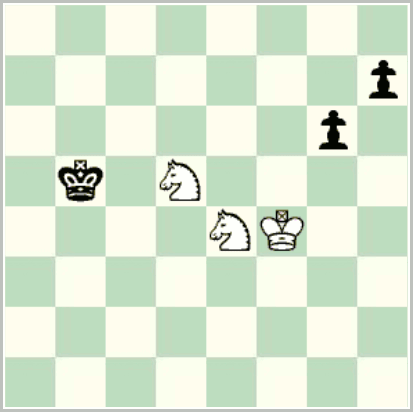The celebrated ending of two knights versus a pawn is the hardest of the ‘basic’ endings, and was exhaustively analyzed long before the tablebase era. Interesting though it is, its importance is mostly theoretical, as the ending is very rare in practice. (It’s sometimes given as an example of what the practical player should not study.)
But “very rare” and “never” are two different things, and the ending cropped up yesterday in the Bunratty Challengers.

48. … ?
The diagrammed position shows the game at the critical point, a couple of moves before the ending in question appeared. The basic idea is well known: White needs to keep one black pawn on the board to avoid stalemate, and will usually need to blockade it behind the ‘Troitsky line’ e4-f5-g6-h4. Even then, the required winning procedure often runs foul of the 50-move rule.
The usual tablebases (e.g., Nalimov) show that from the diagrammed position Black loses with best play in 97 moves, but this does not account for the 50-move rule.
But the Syzygy tablebases give the information we need. From the diagram, Black has four moves that hold the draw via the 50-move rule: 48… Kc4, 48… Kc6, 48… g5+, and 48… h6. Instead, Diana Mirza played 48… h5?. The ending is so obscure that the ‘?’ is harsh, but this changes the valuation. White could now win via 49. Ng5! (only move), blockading the g-pawn behind the Troitsky line. It’s still a close-run thing: after, say, 49… h4 50. Ne3 h3 51. Kg3 Kc5 52. Kxh3, White mates in 49 moves with best play, with the next pawn move resetting the counter in 44 moves.
As it was, White erred with 49. Kg5?, when it’s a draw even without the 50-move rule. Using = to mean drawn with best play without the 50-move rule, and [=] to mean drawn only because of the rule, the play continued 49… Kc4? [=] (49… h4!, only move, =) 50. Ndf6? (50. Ne3+ [=]; 50. Nf4 [=]) 50… h4=. After 51. Kxh4 White continued, optimistically enough, for another 32 moves.
[Click to replay the full game.]
This is not the first Irish game to reach this ending: Keogh – Bjørgvik, World Senior 65+ Championship 2018 is the only other game in the ICU archive that did so. At all relevant stages that game was won for the two knights if not for the 50-move rule, but drawn once the rule is taken into account.

Pingback: 2 knights v. Pawn endgame – Drogheda Chess Club